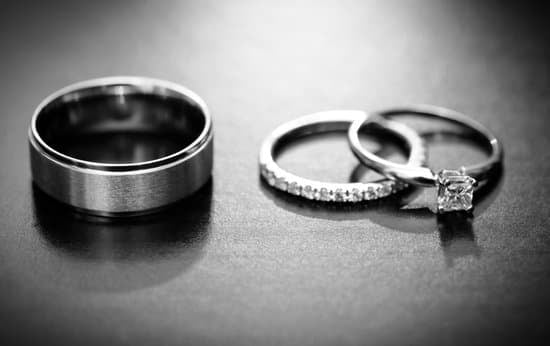A tea ceremony wedding is a traditional ritual that holds great significance in various cultures around the world. This sacred and symbolic ceremony involves the preparation and presentation of tea with deep-rooted traditional rituals.
The act of serving and drinking tea is thought to symbolize respect, love, and unity. In this article, we will delve into the history, traditions, symbolism, and benefits of a tea ceremony wedding, as well as provide guidance on how to incorporate this beautiful tradition into a modern wedding.
The tea ceremony wedding has its origins in ancient China and has since spread to other parts of Asia, including Japan and Korea. Over time, it has become an integral part of wedding celebrations in these cultures and beyond. The ceremony is not just about serving and drinking tea; it also encompasses a series of rituals that symbolize harmony, hospitality, and reverence for one another.
In different cultural contexts, the significance of the tea ceremony varies. For example, in Japanese culture, the tea ceremony (chanoyu or chado) is not only a way to prepare and drink matcha but also a spiritual practice that emphasizes mindfulness, tranquility, and respect for one’s guests.
Similarly, in Chinese culture, the Gongfu Cha ceremony highlights gracefulness, hospitality, and unity through the artful preparation and serving of tea. The universal theme across all these cultures is the emphasis on creating moments of connection and meaning through this beautiful tradition.
History of Tea Ceremony Weddings
The history of the tea ceremony wedding is rich and steeped in tradition. Dating back to ancient China, the tea ceremony was originally used as a way to show respect and gratitude to guests. Over time, this tradition spread to other parts of Asia, including Japan, Korea, and Vietnam. Each culture has its own unique take on the tea ceremony wedding, with special rituals and customs that reflect their values and beliefs.
In China, the tea ceremony wedding dates back over a thousand years and was an integral part of the marriage process. It was a way for the bride and groom to express their gratitude to their parents for raising them. In Japan, the tea ceremony is known as “chanoyu” or “sado,” and it has deep spiritual and philosophical roots. The focus is on grace, tranquility, and simplicity, which are all qualities that are valued in marriage.
As the tea ceremony wedding tradition has evolved over time, it has become not only a symbol of respect and gratitude but also a way to honor one’s cultural heritage. Many couples today choose to incorporate elements of the tea ceremony into their weddings as a nod to their roots and as a way to pay homage to their ancestors.
By understanding the history of the tea ceremony wedding in various cultures, couples can gain a deeper appreciation for this tradition and its significance on their special day.
- It originated in ancient China
- Also present in Japan, Korea, Vietnam
- Symbolizes gratitude towards parents
- Reflects cultural heritage
Tea Ceremony Wedding Traditions
The tea ceremony wedding is a traditional ritual that holds deep cultural significance in many Asian countries, including Japan, China, and Korea. This sacred ceremony symbolizes the union of two individuals through the preparation and serving of tea. The act of making and sharing tea represents hospitality, respect, purity, tranquility, and harmony-all qualities that are essential to a successful marriage.
One of the key components of the tea ceremony wedding is the use of special tea sets and utensils. These items are often heirlooms passed down through generations and hold great sentimental value. The choice of tea used in the ceremony also varies depending on regional customs and personal preferences. In some cultures, green tea or matcha may be used, while others may opt for oolong or jasmine tea.
The actual execution of the tea ceremony involves several intricate rituals performed in a specific order. One such tradition involves the bride and groom serving tea to their elders as a sign of gratitude and respect. The elders then offer their blessings to the couple by sipping the tea. This act symbolizes the formal acceptance of the new member into each family’s fold, signifying unity between both families.
| Element | Description |
|---|---|
| Tea Sets & Utensils | Special items with great sentimental value |
| Choice of Tea | Varies based on regional customs and personal preferences |
| Serving Tea to Elders | Bride and groom serve tea to elders as a sign of gratitude and respect |
The Symbolism of the Tea Ceremony Wedding
In Japanese culture, for example, the act of serving tea is considered an art form that embodies harmony, respect, purity, and tranquility. The simplicity and gracefulness of the ceremony are believed to bring peace and gratitude to both the bride and groom as well as their families.
Similarly, in Chinese culture, tea is seen as a symbol of respect and gratitude. The offering of tea by the newlyweds to their elders signifies their appreciation for their wisdom and guidance; it also serves as a way to seek blessings for a happy marriage.
The use of specific tea sets and utensils also holds symbolic meaning in many cultures. For instance, in some traditions, using a particular type of teapot or teacup may signify good luck or prosperity for the couple.
The way the tea is poured or received can also convey messages – whether it’s making three gentle taps with your fingers to express gratitude in Moroccan tradition or using both hands when receiving a cup to show respect in Korean customs – each action adds layers of symbolism to the overall ceremony.
Ultimately, the symbolism behind a tea ceremony wedding lies in its ability to express profound emotions such as love, unity, and respect through simple yet meaningful gestures. It serves as a reminder that even small acts can carry great significance in building strong relationships and laying the foundation for a harmonious marriage.
Choosing the Right Tea for the Ceremony
A tea ceremony wedding is a traditional ritual that carries deep cultural and symbolic significance. It is an ancient practice dating back centuries, originating in China and later spreading to other parts of Asia, including Japan and Korea. The tea ceremony wedding is a beautiful and meaningful way to honor the union of two individuals, bringing elements of tranquility, respect, and harmony into the celebration.
Choosing the right tea for the ceremony is an essential aspect of the tea ceremony wedding. The type of tea selected can vary depending on cultural traditions, personal preferences, and even the time of year. For example, in Chinese culture, oolong or jasmine tea may be chosen for its fragrant aroma and delicate taste.
In Japanese ceremonies, matcha green tea is often used for its vibrant color and historical importance. It’s important to take into account not only the flavor profile but also the symbolism behind each type of tea when making this decision.
When selecting the perfect tea for your tea ceremony wedding, it’s essential to consider various factors such as taste preference, cultural significance, and the overall theme of your wedding. Whether you opt for a traditional variety or a modern twist on this ancient practice, choosing the right tea will add depth and meaning to your special day.
| Tea Type | Cultural Significance |
|---|---|
| Oolong Tea | Popular choice in Chinese ceremonies; symbolizes good fortune |
| Matcha Green Tea | Used in Japanese ceremonies; represents purity and tranquility |
| Jasmine Tea | Favored in Chinese ceremonies; signifies love and happiness |
How to Include the Tea Ceremony Wedding in Your Wedding
A tea ceremony wedding is a beautiful and meaningful tradition that can be incorporated into modern wedding celebrations. If you are interested in including this cultural ritual in your wedding, there are several ways to do so. Here are some tips on how to include the tea ceremony wedding in your special day:
- Do Your Research: Take the time to learn about the traditional elements and customs of a tea ceremony wedding. Understanding the significance of each ritual will allow you to incorporate them thoughtfully into your own ceremony.
- Choose a Suitable Venue: Find a serene and intimate setting for your tea ceremony, such as a garden, a quiet corner of your reception venue, or even in your own home. The peaceful atmosphere is essential for creating the right ambience for the ceremony.
- Coordinate with Your Officiant: If you are having a traditional Western ceremony as well, coordinate with your officiant to seamlessly integrate the tea ceremony into the overall flow of your wedding day. This may involve adjusting the timing of certain events or incorporating specific rituals.
Including a tea ceremony can add depth and cultural significance to your wedding celebration, creating a meaningful experience not just for you but also for your guests. By taking these steps to include this beautiful tradition in your special day, you can create lasting memories that honor both your love and the rich heritage of the tea ceremony wedding.
Remember that every couple’s journey is unique, so take inspiration from traditional practices but feel free to adapt them to suit your personal preferences and beliefs as well. With careful planning and respect for tradition, the tea ceremony can be seamlessly integrated into modern weddings, adding an unforgettable layer of depth and symbolism to this joyous occasion.
Tea Ceremony Wedding Attire
A tea ceremony wedding is a beautiful and traditional part of many East Asian cultures, including Chinese, Japanese, and Korean. The attire worn during a tea ceremony wedding holds significant cultural and symbolic meaning. Each element of the attire represents deeper aspects of the ceremony and the couple’s union.
Traditional Attire
In a tea ceremony wedding, the bride and groom often wear traditional attire that reflects their cultural heritage. For example, in a Chinese tea ceremony, the bride may wear a qipao or cheongsam, while the groom wears a changshan or Tang suit. In Japanese tea ceremonies, brides may wear a kimono, while grooms wear a montsuki haori hakama. These traditional garments often feature intricate embroidery and vibrant colors that hold specific meanings in the context of marriage.
Symbolism
The attire worn during a tea ceremony wedding is deeply symbolic. The colors, patterns, and fabrics all carry meaning that speaks to ideas of harmony, balance, and prosperity within the marriage. For example, red is often featured in Chinese attire as it symbolizes good luck and happiness. Many traditional outfits also include dragon and phoenix motifs to represent yang (male) and yin (female) energies coming together in harmonious balance.
Significance
Wearing traditional attire during a tea ceremony wedding is not only a way to honor cultural heritage but also signifies respect for tradition and appreciation for the values it represents. The act of donning these garments serves as an outward demonstration of commitment to upholding cultural customs and embracing one’s roots during this significant moment in life.
Overall, being deliberate about selecting traditional tea ceremony wedding attire can add depth and beauty to the ceremonial aspect of this meaningful event”bringing cultural significance to forefront of one’s special day”.
The Benefits of Having a Tea Ceremony Wedding
A tea ceremony wedding is a beautiful and meaningful tradition that can add a unique layer of depth and cultural significance to any wedding celebration. There are numerous benefits to incorporating a tea ceremony into your wedding, from the emotional symbolism to the cultural richness it brings to the event.
Emotional Benefits
One of the most significant benefits of having a tea ceremony wedding is the emotional connection it fosters between the couple and their families. The act of serving and receiving tea during the ceremony symbolizes respect, gratitude, and unity, creating a powerful moment of intimacy and connection between all involved. It provides an opportunity for the couple to express their love and appreciation for their parents and elders, while receiving blessings for their future together.
Cultural Enrichment
In addition to its emotional significance, a tea ceremony wedding also adds cultural enrichment to the celebration. For couples with Asian heritage, it offers an opportunity to honor their ancestral traditions and incorporate them into a modern wedding celebration. Even for couples without Asian heritage, embracing the ritual can be a beautiful way to acknowledge diverse cultures and create a more inclusive atmosphere for all guests.
Symbolic Meaning
Beyond its emotional and cultural significance, each element of the tea ceremony holds symbolic meaning that enriches the overall wedding experience. From the preparation of the tea to the specific utensils used, each aspect has deep-rooted symbolism that represents love, unity, harmony, and respect. By including these symbolic elements in their wedding ceremony, couples can infuse their union with profound meaning and intention.
Overall, a tea ceremony wedding offers myriad benefits that go beyond just adding another ritual to the day’s events. It fosters emotional connections, embraces cultural diversity, and imbues the celebration with rich symbolism that resonates deeply with all those in attendance.
Conclusion
In conclusion, the tea ceremony wedding is a beautiful and meaningful tradition that holds deep significance in many cultures around the world. From its origins to its evolution over time, the tea ceremony has been a symbol of love, unity, and respect. The traditions and customs associated with the tea ceremony are rich with symbolism, representing the values that couples hold dear as they embark on their journey together.
Choosing the right tea for the ceremony is an important part of honoring this tradition. Whether it’s green, black, or white tea, each type carries its own significance and can add to the overall meaning of the ceremony. Incorporating the tea ceremony into a modern wedding may require some logistical planning, but the emotional and cultural benefits far outweigh any challenges.
The attire worn during a tea ceremony wedding also holds great significance. From traditional robes to modern adaptations, each piece of clothing reflects the cultural heritage and values of those participating in this timeless tradition.
Ultimately, having a tea ceremony wedding can add depth and meaning to a couple’s special day, creating a truly memorable experience that honors their love and commitment. Couples considering incorporating this tradition into their wedding should embrace it wholeheartedly as a way to celebrate their union in a unique and culturally significant manner.
Frequently Asked Questions
What Is the Purpose of the Tea Ceremony at a Wedding?
The purpose of the tea ceremony at a wedding is to symbolize the union of two families through the serving and drinking of tea. It is a way for the couple to show respect and gratitude to their parents and elders, as well as receive their blessings for a happy marriage.
What Is the Meaning of Tea Wedding?
The meaning of a tea wedding is that it represents tradition, harmony, and respect for family in many Asian cultures. The ceremony itself holds symbolism in the way the tea is prepared, served, and drunk, often signifying different aspects of the couple’s relationship and their new life together.
Is Tea Ceremony Same Day as Wedding?
Whether or not the tea ceremony takes place on the same day as the wedding varies based on individual preferences and cultural customs. In some traditions, it may be held before or after the wedding day itself. However, it is common for many couples to incorporate the tea ceremony into their actual wedding day schedule as part of the celebration.

I have been involved in marriages for over 20 years helping couples and singles understand more about them.





